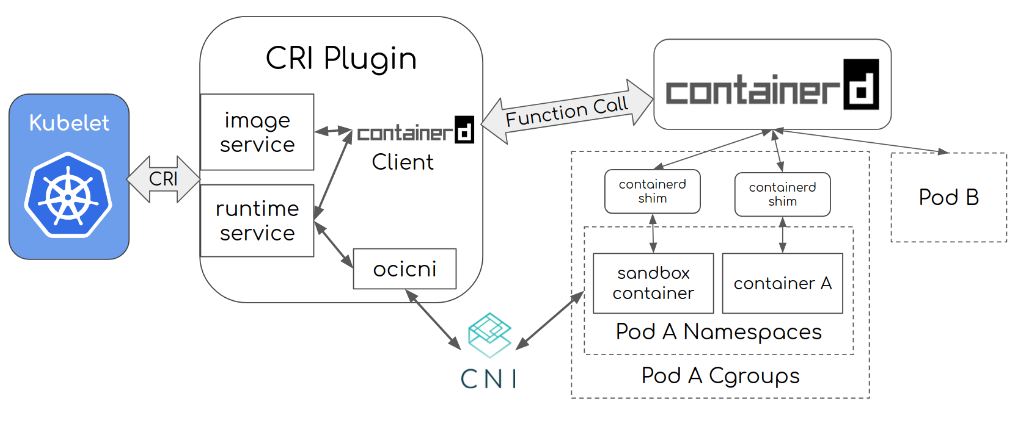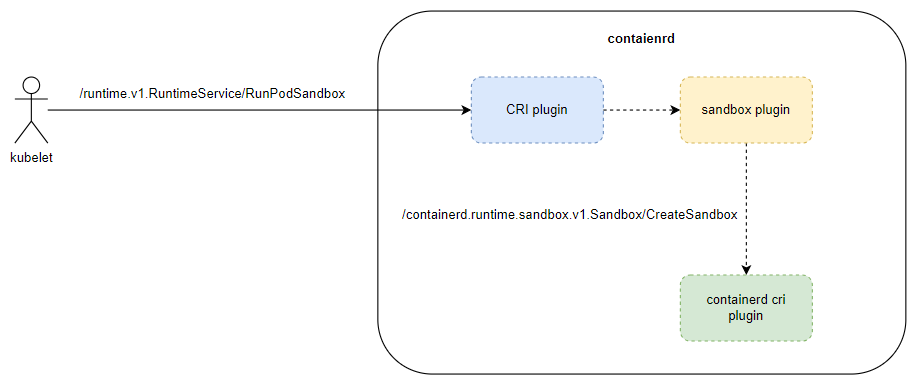containerd 源码分析:kubelet 和 containerd 交互
0. 前言
Kubernetes:kubelet 源码分析之创建 pod 流程 介绍了 kubelet 创建 pod 的流程,其中介绍了 kubelet 调用 runtime cri 接口创建 pod。containerd 源码分析:启动注册流程 介绍了 containerd 作为一种行业标准的高级运行时的启动注册流程。那么,kubelet 是怎么和 containerd 交互的呢? 本文会带着这个问题分析 kubelet 和 containerd 的交互。
1. kubelet 和 containerd 交互
1.1 kubelet
如 Kubernetes:kubelet 源码分析之创建 pod 流程 分析,kubelet 调用 runtime cri 接口 /runtime.v1.RuntimeService/RunPodSandbox 创建 pod:
// kubernetes/vendor/k8s.io/cri-api/pkg/apis/runtime/v1/api.pb.go
func (c *runtimeServiceClient) RunPodSandbox(ctx context.Context, in *RunPodSandboxRequest, opts ...grpc.CallOption) (*RunPodSandboxResponse, error) {
out := new(RunPodSandboxResponse)
err := c.cc.Invoke(ctx, "/runtime.v1.RuntimeService/RunPodSandbox", in, out, opts...)
if err != nil {
return nil, err
}
return out, nil
}
kubelet 是 runtime cri 接口调用的客户端,那么容器运行时作为服务端是怎么提供服务的呢?
1.2 kubelet 和 containerd 交互流程
在介绍容器运行时提供的服务之前先看下 cri 架构图。

从图中可以看出,containerd 的 CRI 插件提供 image service 和 runtime service,负责对接 kubelet runtime cri 的接口调用,并将调用转发给 containerd。
继续,查看 containerd 的处理流程。
1.3 containerd
1.3.1 CRI Plugin
根据 cri 架构图, 从 CRI 插件入手查看 id 为 io.containerd.grpc.v1.cri 的 CRI 插件。
// containerd/plugins/cri/cri.go
func initCRIService(ic *plugin.InitContext) (interface{}, error) {
...
// Get runtime service.
criRuntimePlugin, err := ic.GetByID(plugins.CRIServicePlugin, "runtime")
if err != nil {
return nil, fmt.Errorf("unable to load CRI runtime service plugin dependency: %w", err)
}
// Get image service.
criImagePlugin, err := ic.GetByID(plugins.CRIServicePlugin, "images")
if err != nil {
return nil, fmt.Errorf("unable to load CRI image service plugin dependency: %w", err)
}
...
service := &criGRPCServer{
RuntimeServiceServer: rs,
ImageServiceServer: is,
Closer: s, // TODO: Where is close run?
initializer: s,
}
if config.DisableTCPService {
return service, nil
}
return criGRPCServerWithTCP{service}, nil
}
插件返回的是 criGRPCServerWithTCP 对象。其中,包括 criGRPCServer 对象。criGRPCServer 对象实现了 grpcService 接口,将调用接口的 Register 注册对象到 grpc server。
// containerd/plugins/cri/cri.go
// Register registers all required services onto a specific grpc server.
// This is used by containerd cri plugin.
func (c *criGRPCServer) Register(s *grpc.Server) error {
return c.register(s)
}
func (c *criGRPCServer) register(s *grpc.Server) error {
instrumented := instrument.NewService(c)
runtime.RegisterRuntimeServiceServer(s, instrumented)
runtime.RegisterImageServiceServer(s, instrumented)
return nil
}
在 criGRPCServer.register 中创建 instrumentedService 对象。
type instrumentedService struct {
c criService
}
func NewService(c criService) GRPCServices {
return &instrumentedService{c: c}
}
instrumentedService 包括 criService 对象。实际提供 runtime service 和 image service 的就是 criService 对象。
以注册 runtime service 为例,查看 runtime.RegisterRuntimeServiceServer(s, instrumented) 做了什么。
// containerd/vendor/k8s.io/cri-api/pkg/apis/runtime/v1/api.pb.go
func RegisterRuntimeServiceServer(s *grpc.Server, srv RuntimeServiceServer) {
s.RegisterService(&_RuntimeService_serviceDesc, srv)
}
var _RuntimeService_serviceDesc = grpc.ServiceDesc{
ServiceName: "runtime.v1.RuntimeService",
HandlerType: (*RuntimeServiceServer)(nil),
Methods: []grpc.MethodDesc{
{
MethodName: "Version",
Handler: _RuntimeService_Version_Handler,
},
{
MethodName: "RunPodSandbox",
Handler: _RuntimeService_RunPodSandbox_Handler,
},
...
},
...
}
可以看到,注册 instrumentedService 到 grpc 中,instrumentedService 提供 runtime.v1.RuntimeService 服务,包括 kubelet 调用的 RunPodSandbox 方法。
继续看,instrumentedService 的 RunPodSandbox 做了什么。
// containerd/internal/cri/instrumented_service.go
func (in *instrumentedService) RunPodSandbox(ctx context.Context, r *runtime.RunPodSandboxRequest) (res *runtime.RunPodSandboxResponse, err error) {
...
res, err = in.c.RunPodSandbox(ctrdutil.WithNamespace(ctx), r)
return res, errdefs.ToGRPC(err)
}
instrumentedService 调用 criGRPCServer 的 RunPodSandbox 方法,实际执行的是 criGRPCServer 中的 criServer 对象:
// containerd/internal/cri/server/sandbox_run.go
func (c *criService) RunPodSandbox(ctx context.Context, r *runtime.RunPodSandboxRequest) (_ *runtime.RunPodSandboxResponse, retErr error) {
...
if err := c.sandboxService.CreateSandbox(ctx, sandboxInfo, sb.WithOptions(config), sb.WithNetNSPath(sandbox.NetNSPath)); err != nil {
return nil, fmt.Errorf("failed to create sandbox %q: %w", id, err)
}
ctrl, err := c.sandboxService.StartSandbox(ctx, sandbox.Sandboxer, id)
if err != nil {
...
}
...
}
criService.RunPodSandbox 调用的是 sandboxService 的 CreateSandbox 和 StartSandbox 方法。
1.3.2 sanbox Plugin
sandboxService 在 cri.initCRIService 中实例化:
// containerd/plugins/cri/cri.go
func initCRIService(ic *plugin.InitContext) (interface{}, error) {
...
sbControllers, err := getSandboxControllers(ic)
if err != nil {
return nil, fmt.Errorf("failed to get sandbox controllers from plugins %v", err)
}
...
options := &server.CRIServiceOptions{
RuntimeService: criRuntimePlugin.(server.RuntimeService),
ImageService: criImagePlugin.(server.ImageService),
StreamingConfig: streamingConfig,
NRI: getNRIAPI(ic),
Client: client,
SandboxControllers: sbControllers,
}
...
s, rs, err := server.NewCRIService(options)
...
service := &criGRPCServer{
RuntimeServiceServer: rs,
ImageServiceServer: is,
Closer: s, // TODO: Where is close run?
initializer: s,
}
}
首先,getSandboxControllers 获得 sandbox controllers:
// containerd/plugins/cri/cri.go
func getSandboxControllers(ic *plugin.InitContext) (map[string]sandbox.Controller, error) {
// plugins.SandboxControllerPlugin: "io.containerd.sandbox.controller.v1"
sandboxers, err := ic.GetByType(plugins.SandboxControllerPlugin)
if err != nil {
return nil, err
}
...
return sc, nil
}
sandbox.Controller 是类型为 io.containerd.sandbox.controller.v1 的插件对象。将该对象作为 options 赋给 criServer:
// containerd/internal/cri/server/service.go
func NewCRIService(options *CRIServiceOptions) (CRIService, runtime.RuntimeServiceServer, error) {
...
c := &criService{
...
sandboxService: newCriSandboxService(&config, options.SandboxControllers),
}
...
}
func newCriSandboxService(config *criconfig.Config, sandboxers map[string]sandbox.Controller) *criSandboxService {
return &criSandboxService{
sandboxControllers: sandboxers,
config: config,
}
}
criService.sandboxService.CreateSandbox 调用的是插件对象 sanbox controllers 的 CreateSandbox 方法,该方法最终调用的是 sandboxClient 的 CreateSandbox:
func (c *sandboxClient) CreateSandbox(ctx context.Context, in *CreateSandboxRequest, opts ...grpc.CallOption) (*CreateSandboxResponse, error) {
out := new(CreateSandboxResponse)
err := c.cc.Invoke(ctx, "/containerd.runtime.sandbox.v1.Sandbox/CreateSandbox", in, out, opts...)
if err != nil {
return nil, err
}
return out, nil
}
可以看到,在 sandboxClient.CreateSandbox 中调用 containerd 提供的 containerd cri 接口 /containerd.runtime.sandbox.v1.Sandbox/CreateSandbox,该接口用来创建 sandbox,即 pod。
1.4 创建 pod 流程
根据上述分析,这里画出 kubelet 到 containerd 的交互流程图如下:

2. 小结
本文在前文 Kubernetes:kubelet 源码分析之创建 pod 流程 和 containerd 源码分析:启动注册流程 的基础上,进一步分析从 kubelet 到 containerd 的交互流程,打通了 kubelet 到 containerd 这一步。






 浙公网安备 33010602011771号
浙公网安备 33010602011771号